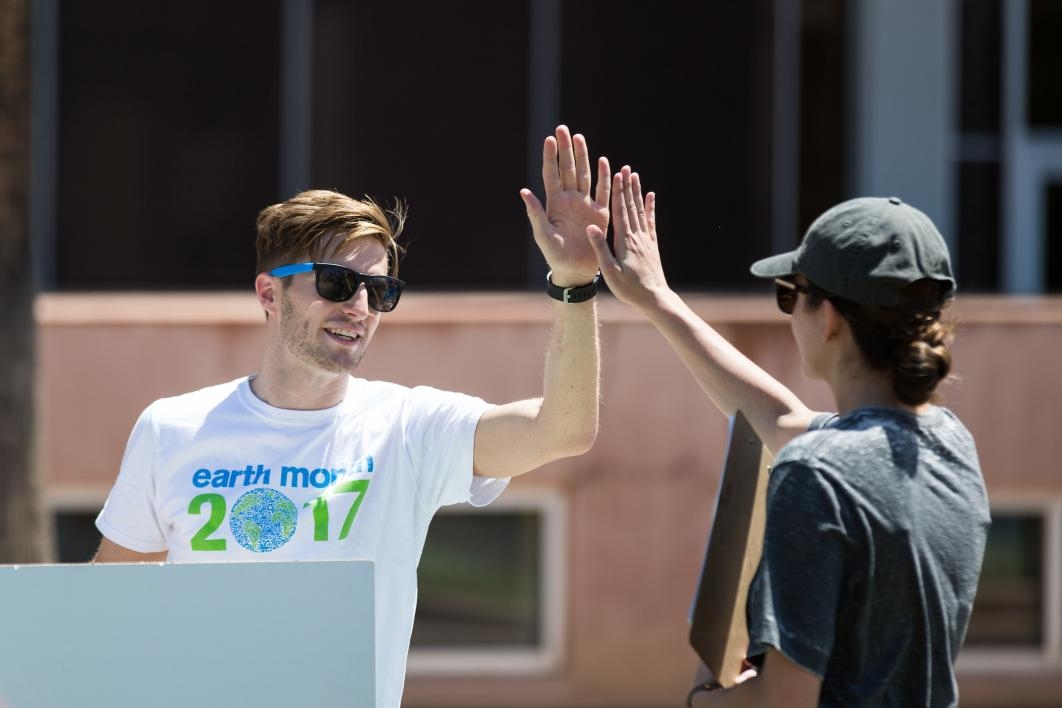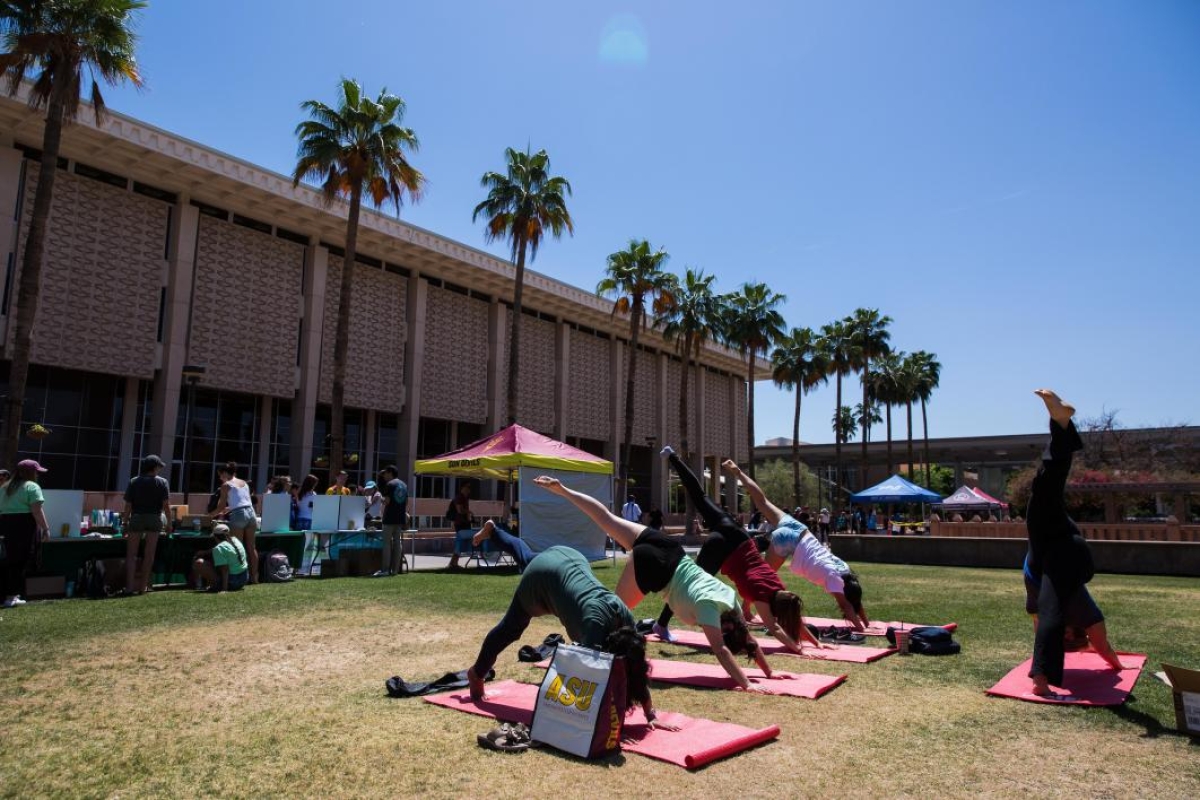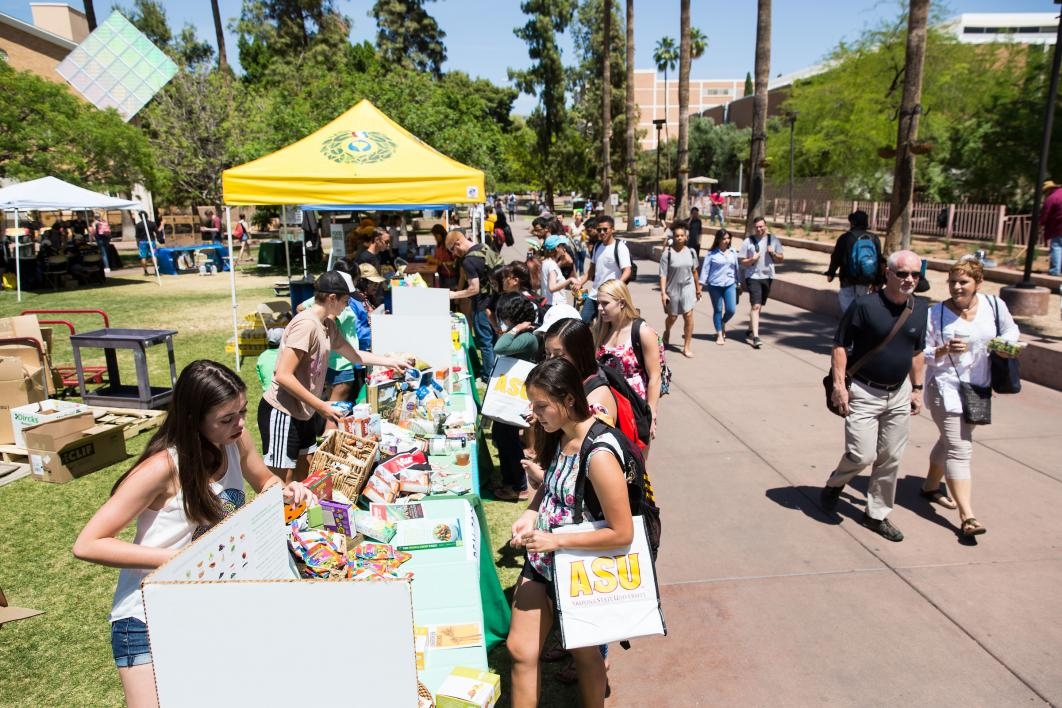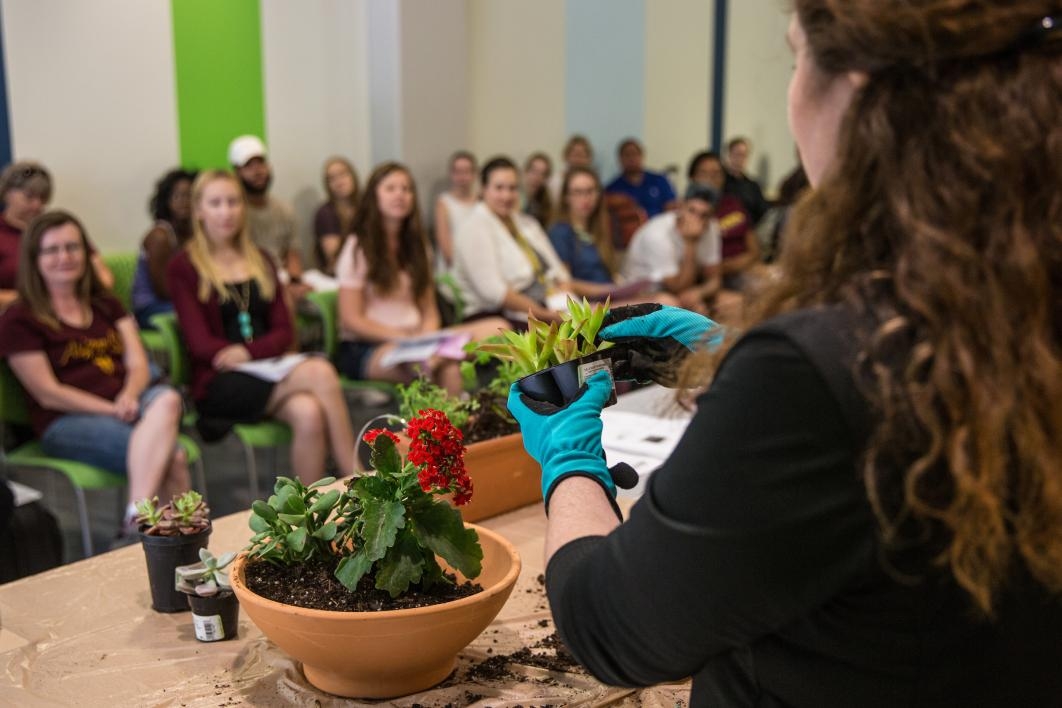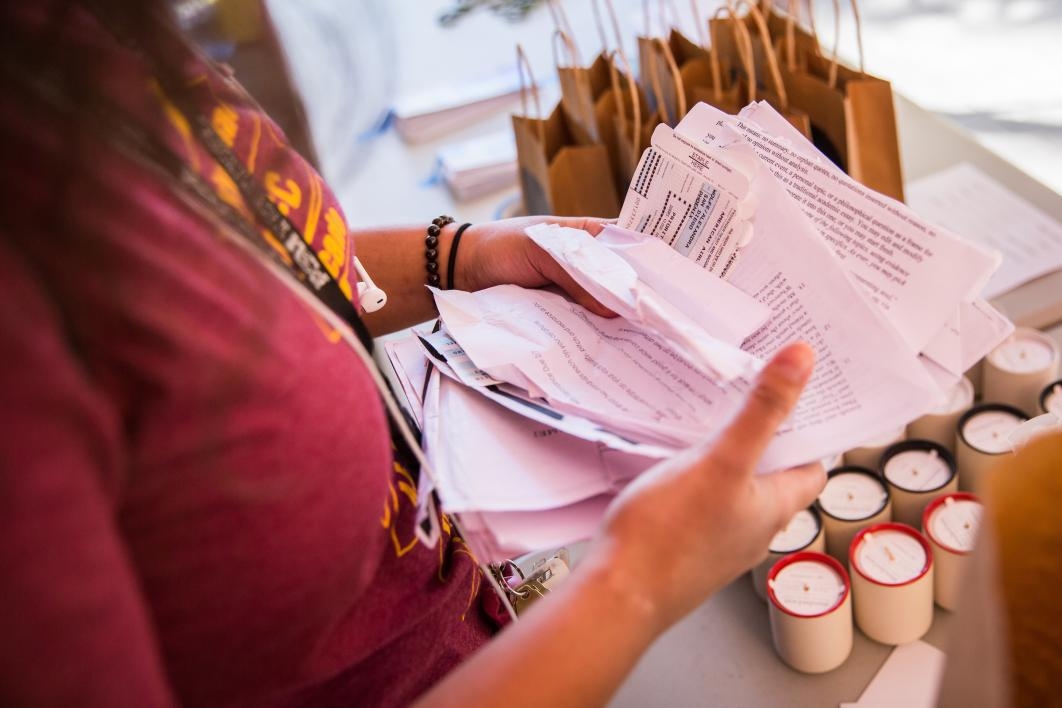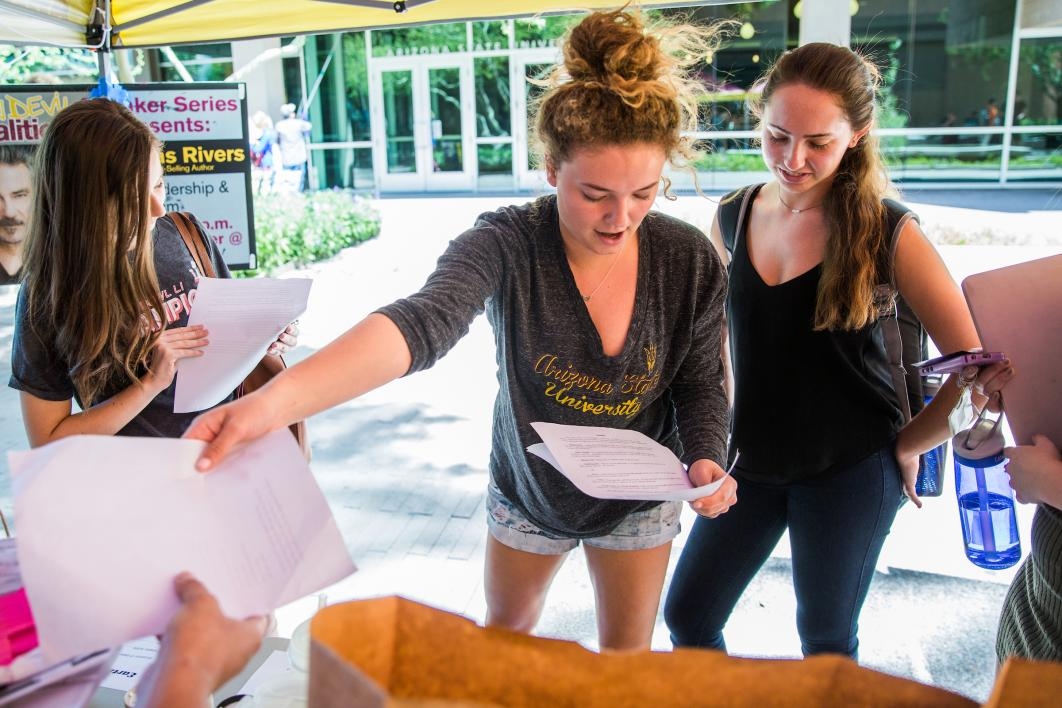Over the past academic year, Kendon Jung noticed something about the 77 sustainability-related student groups he oversaw at ASU: Though they shared common goals, they were working separately to achieve them instead of combining forces.
This week's Earth Festival on Hayden Lawn in Tempe was the first step toward fostering a coalition to change that. Sustainability student groups from multiple campuses came together to network, showcase their missions and achievements, and participate in a town hall conversation.
Jung, a student activity adviser, said having a sustainability coalition at ASU will “organize students in a way that they can collaborate, brainstorm and put together projects that will be resilient, implementable” and that will “move the sustainability needle forward.”
It should be no surprise that so many ASU students are invested in the cause; the university was the first in the nation to offer a degree in sustainability in 2006 and has been at the forefront of the movement since, most recently earning a 2017 Best of Green Schools award from the Center for Green Schools at the U.S. Green Building Council, in collaboration with the Green Schools National Network. That honor was preceded by a top 10 spot in Sierra magazine’s 10th annual “Cool Schools” ranking of America’s greenest colleges and universities in September.
The reason behind that kind of recognition can be seen everywhere at ASU, from its LEEDLEED stands for Leadership in Energy and Environmental Design, and is one of the most popular green building certification programs used worldwide.-certified buildings, to its solar-panel-shaded parking lots, to its green-certified restaurants.
But sustainable physical operations alone aren’t enough, director of University Sustainability Practices Mick Dalrymple said. You’ve also go to implement principled practice and active engagement — in other words, you’ve also got to change people’s thoughts and behaviors.
“I call it walking the talk,” he said. “We’re trying to get people to rethink what sustainability looks like.”
What it looks like is giving employees the option to work from home, making alternative forms of transportation more accessible and changing the default copier setting to two-sided printing, among other things, he said.
“The bottom line is that the Earth is going to go on. Whether it goes on with us or without us is the question,” Dalrymple said. And if we want it to go on with us, “we have to realign our man-made systems with natural systems.”
Here are some of the ways ASU is doing that:
Video by Ken Fagan/ASU Now
Energy conservation and production
The most visible manifestation of ASU’s sustainable energy efforts are its vast expanses of solar panels, spread out over parking lots and roofs, and its power parasols, giant collections of solar panels that tower over pedestrians on campus malls, providing shade and cooling the surrounding area while generating energy.
In January of this year, ASU partnered with a solar power plant in Red Rock, Arizona, increasing the university’s renewable-energy use by 150 percent and adding to the nearly 90 existing solar installations spread out across its campuses. Those installations produce more than 24 MWdcMWdc stands for megawatts in the form of direct current., one of the largest on-campus university solar-energy portfolios in the nation, and enough energy required to power 3,366 homes for one year. The new Red Rock partnership will push the university past a new milestone of 50 MWdc, more than double its current renewable-energy capacity.
“It sends a message to our community, and in particular to our students, that this is what a sustainable campus can look like,” Gerald DaRosa, director of ASU Energy Innovations, said. “My hope is that they come to expect this as the norm, so that when our students progress through their lives and become parents, teachers, engineers and executives, they demand the same and more, eventually raising the bar even higher.”
Energy Innovations is only two years old at the university, but the department’s function is invaluable; mainly, it’s responsible for ensuring as much energy conservation and efficiency is being achieved as possible and also for identifying renewable-energy opportunities on- and off-campus.
Currently, they’re looking into how emerging battery technology has the potential to store energy generated by solar panels so it can still be used when the sun goes down. They’re hoping to install a battery system that will be used to power a small building within the next 12 months.
Within ASU’s many buildings are a number of existing features that help with energy reduction, such as motion-activated lights, something that has helped contribute to the university’s 47 certified-LEED projects.
Zero Waste
ASU’s commitment to diverting waste from the landfill is seen all over its campuses and surrounding areas, in the form of the ubiquitous Blue Bins cozied up next to every trash can. The folks behind those efforts are members of the Zero Waste Department, an initiative that provides leadership development and hands-on experience in waste-diversion and aversion tactics.
Department assistant director Alana Levine said the difference is that diversion keeps waste out of landfills through recycling or repurposing while aversion keeps things that could become waste from proliferating in the first place. An example of aversion is the newly available reusable cup that provides free refills at all Tempe campus athletic events. Using the same cup instead of a new one every time you get a drink at a game reduces the number of paper cups that would otherwise be produced and then become waste.
Some of Zero Waste’s other initiatives include the Blue Bag recycling program, launched in 2015 to capture traditionally hard-to-recycle items, such as batteries and food wrappers; “green” sports games, where Zero Waste staff sort, weigh and calculate a diversion rate for the total waste produced; Recyclemania, a yearly, eight-week-long competition among colleges and universities throughout the U.S. and Canada; Ditch the Dumpster, a program that allows students who are moving out of dorms to donate, repurpose or recycle items they no longer need instead of throwing them away; and the No Wasted Paint Program, which collects and reuses old paint on campus.
The ASU Canon Strategic Alliance Partnership is helping reduce paper waste by better assessing individuals’ and departments’ printing needs. So far, it has reduced printing waste from 100 million pages a year to about 45 million.
ASU is also leading by example on the food production and consumption front. Many campus restaurants and shops offer locally sourced food, sometimes even from campus itself. Engrained, on the top floor of the Memorial Union, recently received a Green Restaurant Certification for such sustainable practices, and every year, various campuses host fruit harvests. There are also a number of gardening and composting efforts.
Water waste is also on the university’s radar, with a goal of cutting water use in half and eliminating all wastewater by 2020. Proposals have been made for a water reclamation facility on campus that would allow ASU to treat its own wastewater and reuse it. The university is also looking to retrofit fixtures in older buildings with antiquated bathrooms and to begin metering buildings to measure how much water is actually being used. Even landscaping is considered, with ideas for weather-sensitive sprinkling systems that can tell when it rains.
Everywhere you look at ASU, there are ways to help reduce your environmental footprint, Levine said. It’s just a matter of getting started.
“Don’t get overwhelmed by all the options,” she said. “Start with your initial actions that are doable, and then build on that,” such as carrying a reusable mug, or bringing your lunch in Tupperware instead of one-time-use bags. “You don’t have to change your entire life right away. There’s always a starting point and then a next step to take.”
Carbon neutrality
ASU has set a goal of carbon neutrality for its buildings — several of which are already LEED-certified — by 2025, and for buildings and transportation combined by 2035. During fiscal year 2016, renewable-energy use at ASU avoided approximately 21,700 metric tons of carbon dioxide equivalent, roughly equal to the annual emissions of 4,500 passenger vehicles.
Also aiding in the cause are the number of alternative transportation options offered by the university, such as intercampus shuttles; bike lanes and valets; and employee and student Valley Metro light rail unlimited-ride passes. Online courses and employee telecommunication options also help cut down on transportation emissions.
“People don’t realize the incredible impact transportation has had,” Dalrymple said. “We’ve made significant strides in that area.”
And ASU is doing the same in construction, he added. The campus’ newest building, the in-progress Student Pavilion on the Tempe campus, will be the university’s first net zero-energy building, meaning it will use no more energy than can be produced on site annually.
Walking the talk
Dalrymple said it’s a goal of University Sustainability Initiatives “to implement sustainability into every function of the university.”
From student groups, to construction practices, to waste diversion, to energy production, to sustainable dining, that goal is already a reality. What all those things do, combined, Dalrymple said, is help to change people’s overall mind-set about sustainability in general.
“When I started working in this field in 2001, we were talking about (environmental effects on our) grandchildren,” Dalrymple said. “But we’re seeing impacts now. It’s not just going to impact our grandchildren, it’s going to impact us in our lifetimes … and we need to make the right choices now.
“The future will be determined by what we do now.”
In celebration of Earth Month and in anticipation of Earth Day on Saturday, a number of events have been taking place all over ASU. Aside from the student group Earth Festival on Hayden Lawn in Tempe, there was a screening of the climate-change documentary “Before the Flood” at the West campus, a farmers’ market at the Polytechnic campus and a gardening and cooking workshop at the Downtown Phoenix campus.
For a full list of Earth Month events at ASU, click here.
Top photo: Julie Ann Wrigley Global Institute of Sustainability staffer Trinity Dosemagen (left) and senior sustainability major Dania LaScola try their hand at the Future Builder game during the Student Sustainability Club Earth Day Festival on Hayden Lawn on April 19. The game assigns colors to money, resources and people and asks you to build a Jenga tower and borrow from it to play the game. Photo by Deanna Dent/ASU Now
More Environment and sustainability

ASU to host new Global Coordination Hub
In a new partnership between the global research network Future Earth and Arizona State University, the Julie Ann Wrigley Global Futures Laboratory will house a new hub to coordinate…

A world full of plastic ... not fantastic
Editor’s note: This is the seventh story in a series exploring how ASU is changing the way the world solves problems.When Timothy Long’s kids were growing up, he never let them toss…

Team wins $10M XPRIZE Rainforest competition for novel solution
Several Arizona State University experts are on a team that created a new way to put a price on the rainforest in order to save it, and on Friday they won the top award in the prestigious $10 million…

